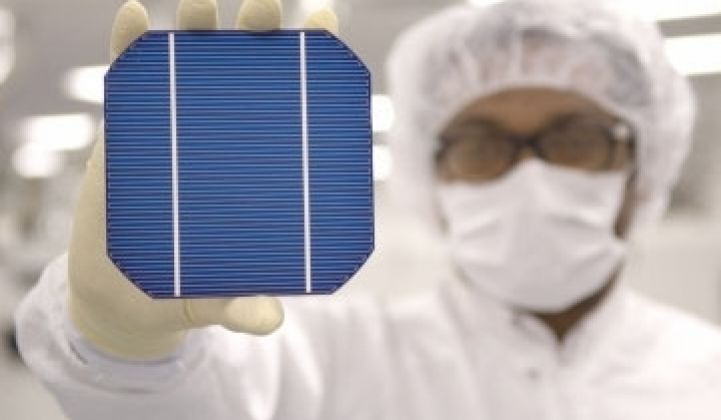Wei Shan, the Principal Scientist and Senior R&D Director at JA Solar, presented at today's OIDA event in Santa Clara, California. Before we get to the (interesting) content of his talk, let's go over some JA Solar background.
JA Solar by the numbers (projections according to Barclays):
- Q2 shipments likely tracking above 290 megawatts (June shipments ~80-100 megawatts)
- Higher cell ASPs in Q2, along with small reliance in spot wafer market, could result in Q2 margin upside
- Post Intersolar checks indicate that the company is completely sold out through rest of 2010 and is currently allocating product to select customers.
- Q3 shipments could approach 300 to 330 megawatts; stable pricing/wafer costs could drive 20-percent-plus margins.
- Barclays expects Q2 revenues of $338 million (versus street expectations of $300 million) on 290 megawatt shipments, 20.8% GM, $1.31 per watt cell ASPs vs. prior forecast of $314 million on 275 megawatts shipments, 19.5% GM, $1.28 per watt cell ASPs.
The solar behemoths that are typically targeted as the leaders to beat are First Solar and SunTech. But JA Solar has to be included in that roster, as well, as evinced by their expected second quarter numbers -- 100 megawatts per month puts them in the rarefied gigawatt-per-year category.
On to the contents of Wei Shan's talk:
JA Solar is going after higher efficiency, and they are doing it on the back of technology from a Silicon Valley-based VC-funded startup, Innovalight. It's not a surprise that JA is working with Innovalight; that was revealed in my interview with Innovalight CEO months ago. What is a bit surprising is the extent to which JA is leveraging the Innovalight technology. Indeed, Mr. Shan's talk was dominated by the topic of Innovalight technology and how it will improve JA Solar's efficiency.
Innovalight has developed a silicon ink composed of "perfectly crystalline silicon particles 5nm in size" in an ink-like matrix, which Innovalight's CEO Conrad Burke claims can boost the efficiencies of crystalline silicon wafers from one to perhaps two percentage points. In a market where a tenth of a percentage point gain in efficiency often warrants a press release, a one percent increase is significant. The use of the ink in a production line could conceivably transform a 30-megawatt line into a 35-megawatt line.
Back to JA Solar: The process that incorporated the Innovalight ink is the sonorously named SECIUM process and has allowed JA Solar to announce R&D efficiency results of greater than 18.5 percent at the module cell level. Importantly, the modification to the production line is accomplished with "one step added to a conventional cell line" according to Shan, and it "can be mass produced cost-effectively."
Shan added that the results have been verified by Frauhofer and that they are in the midst of performing reliability testing. He mentioned that relative efficiency is raised by about six percent using the Innovalight process.
One of the attendees commented to me that "the government finances Innovalight and the technology goes to China." I let that comment percolate in my head for a while.
And I concluded that that reasoning is faulty.
JA Solar incorporates a Silicon Valley startup's innovative technology into a global-scale manufacturing line, generates revenue for the startup and potential return for the investors, and moves the solar efficiency bar higher in a cost-efficient manner. Modules get cheaper and more productive, and grid parity gets closer and closer.
The solar world is getting flatter -- and nationalistic jingoism is not going to help.



